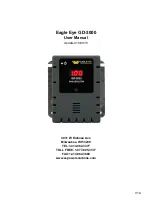
13
Proper use of alarm contact
The monitor’s alarm contact is used to transmit signals to activate an air-conditioning control.
The specifications for the external output gas alarm contact of the monitor are based on the resistance
load conditions. If inductive load is used at the alarm contact, the following errors will likely occur due to
counter electromotive force generated at the contact:
- Defective insulation or defective contact at the relay contact
- Damage of any electric parts due to high-voltage generated inside the monitor
- Abnormal operations by an out-of-control CPU
If a load is activated, the following measures must be taken to stabilize the monitor’s operation and to
protect the alarm contact:
- Relay it with an external relay at a lower voltage of 100 VAC or below (contact amplification). At the
same time, the surge absorbing part SK1 suitable for the specifications must be attached to the
external relay.
- In addition, the surge absorbing part SK2 must be attached to the loaded side of the external relay if
necessary.
- For certain load conditions, it is recommended that the surge absorbing part be attached to the contact.
It must be attached to an appropriate location by checking how the load is activated.
CAUTION
•
While in a de-energized state, the b contact (break contact) may be opened momentarily by a
physical shock, such as external force.
•
When the b contact is selected for the alarm contact, take appropriate actions to prepare for a
momentary activation, for example, add signal delay operation (approximately one second) to the
receiving side of the b contact.
RI-600
CAUTION
•
In principle, do not activate inductive load at the alarm contact of the monitor. In particular, never
use an inductive load to activate a fluorescent lamp or motor, etc.
•
If an inductive load is activated, relay it with an external relay (contact amplification). However,
because the coil of an external relay also involves inductive load, select a relay at a lower voltage
(100 VAC or below), and then protect the contact of the monitor with an appropriate surge
absorbing part, such as a CR circuit.
Alarm contact
Power
supply
Power
supply
Co
il
External relay
(Lower voltage relay)
Load
*SK1, SK2: Surge absorbing part














































